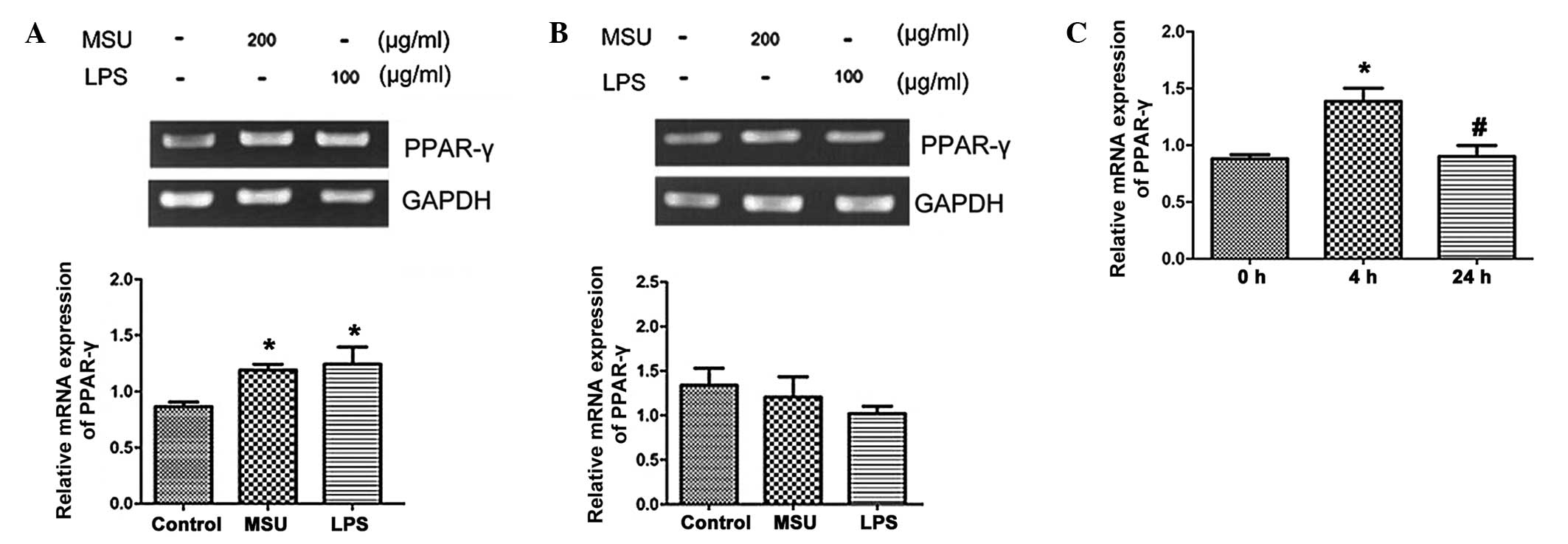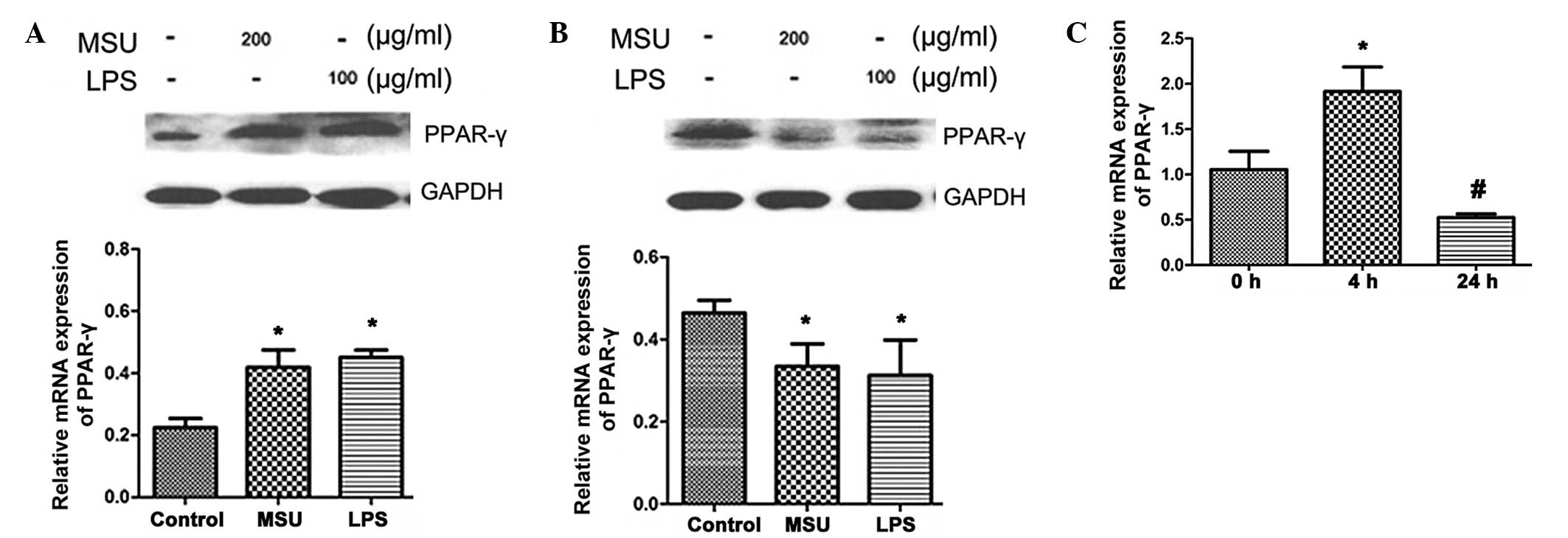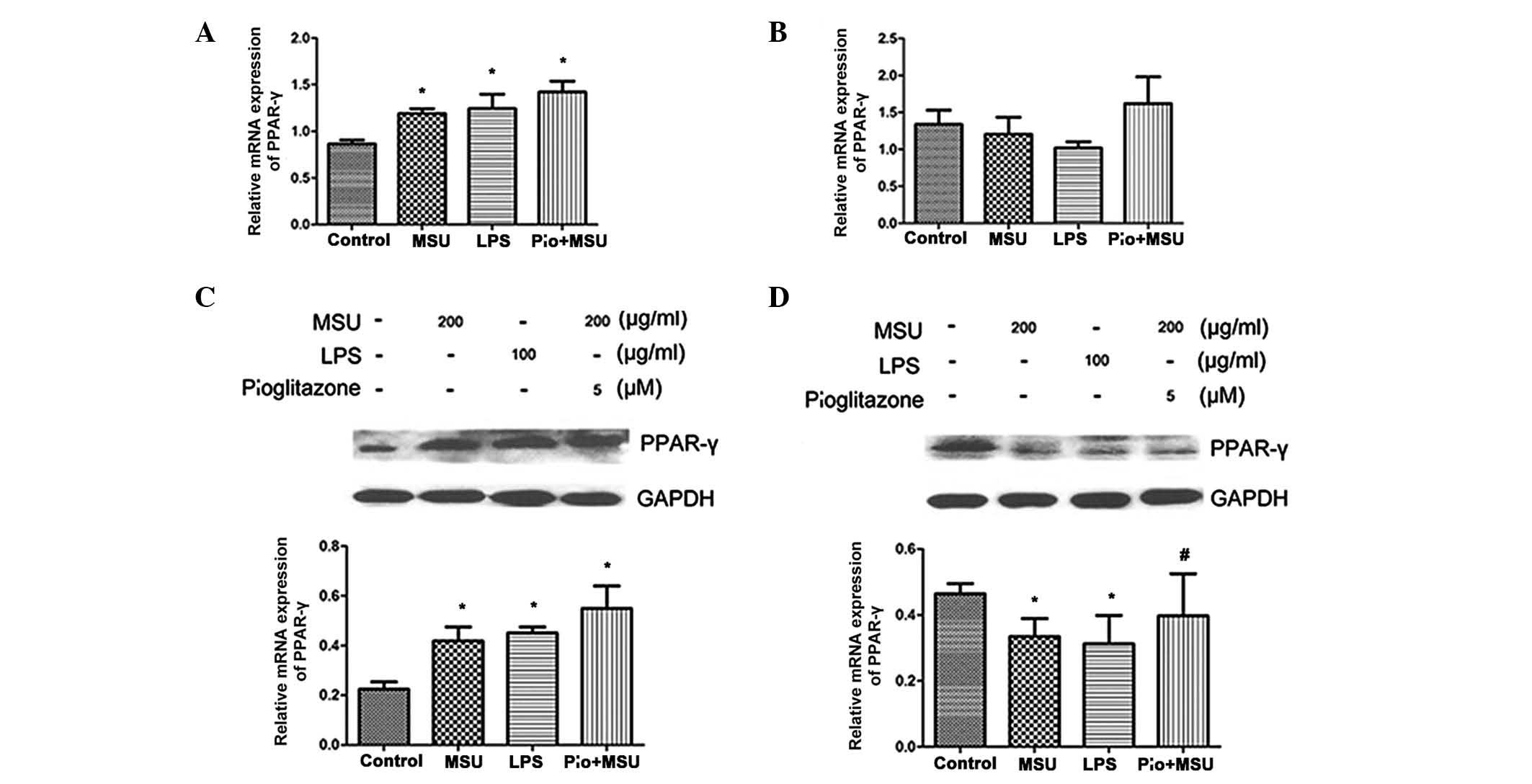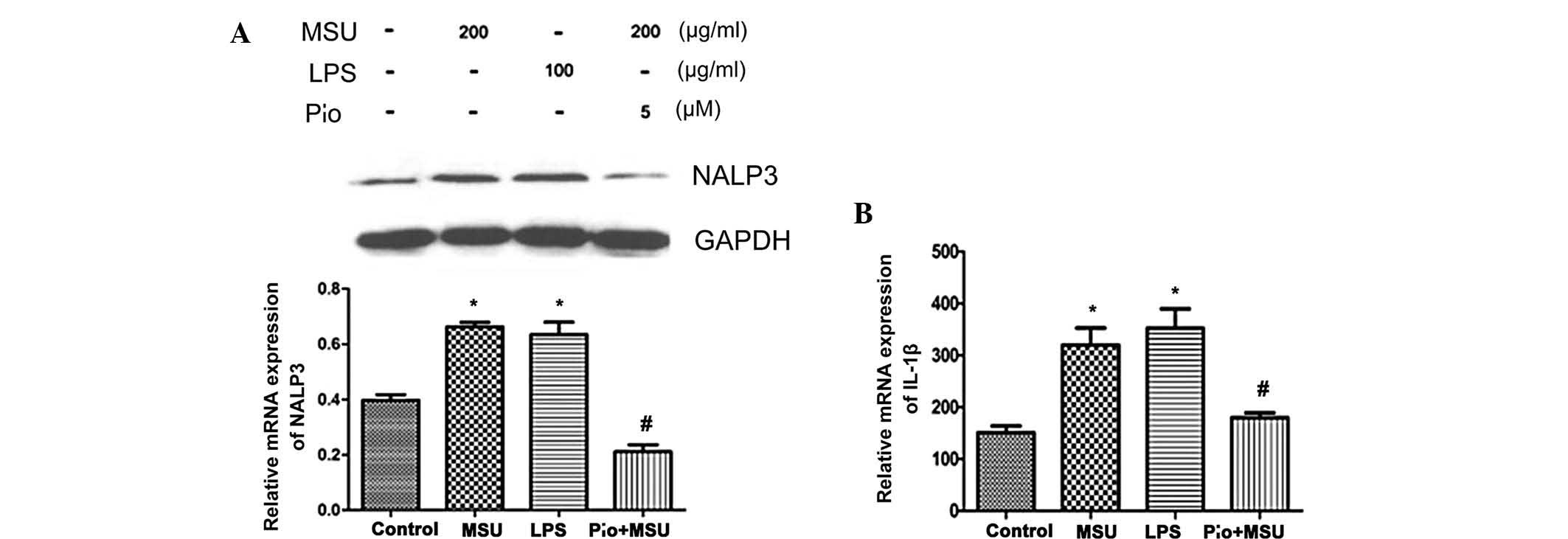Peroxisome proliferator‑activated receptor γ prevents the production of NOD-like receptor family, pyrin domain containing 3 inflammasome and interleukin 1β in HK‑2 renal tubular epithelial cells stimulated by monosodium urate crystals
- Authors:
- Published online on: July 29, 2015 https://doi.org/10.3892/mmr.2015.4145
- Pages: 6221-6226
Abstract
Introduction
The incidence of hyperuricemia is steadily increasing in the world population and has therefore become a focus of recent studies (1,2). Hyperuricemia is not only a marker of chronic kidney disease but is also an independent risk factor for numerous types of kidney disease (3,4). Experimental studies have demonstrated a variety of mechanisms by which hyperuricemia causes the development of renal disease. One of the key mechanisms of hyperuricemia-induced kidney injury is the inflammation provoked by monosodium urate (MSU) crystals (5–7). MSU crystals were first identified as the etiological agent of gout in the eighteenth century and more recently as a danger signal released from dying cells (8).
NOD-like receptor (NLR) family, pyrin domain containing 3 (NALP3) inflammasome and interleukin (IL)-1β were reported to be crucial molecules in MSU crystal-mediated inflammation. NALP3 inflammasome is an innate immune complex that contains NALP3, caspase-recruitment domain (CARD)-8, and apoptosis-associated speck-like protein containing a CARD (ASC). NALP3 is a member of the NLR family, which not only detects microbial structure but also senses endogenous danger signals such as uric acid released from injured cells (9). ASC is an essential component of the NALP3 inflammasome, as it can recruit caspase-1 to the inflammasome (10), while the protein CARD-8 normally inhibits activation of caspase-1 (11). NALP3 inflammasome controls IL-1β production by recruiting caspase-1, which directly cleaves cytokine IL-1β precursors into active forms (12). Martinon et al (9) reported that MSU crystals induced inflammation, activation of NALP3 inflammasome, and production of active IL-1β and IL-18. Furthermore, an impaired neutrophil influx was found in inflammasome-deficient mice. Miao et al (13) suggested that gene mutations in NALP3 and CARD-8 may contribute to susceptibility to gout.
IL-1β belongs to the IL-1 family of cytokines and is pivotal to the regulation of innate and adaptive immunity (14). Chen et al (15) showed that Il-1β is important in MSU crystal-induced inflammation based on findings of a markedly decreased inflammatory response to MSU crystals in IL-1R-deficient mice. The finding that IL-1β inhibition was efficacious in the treatment of MSU crystal-induced inflammation suggested a crucial role for IL-1β in this type of inflammation (16).
Peroxisome proliferator-activated receptor γ (PPARγ) belongs to the nuclear hormone receptor superfamily and acts as a transcriptional regulator of numerous target genes by forming heterodimers with the retinoid X receptor (17). PPARγ is expressed not only in white adipose tissue but also in proximal tubular cells (18). It has been evidenced that activation of PPARγ attenuated the expression of pro-inflammatory mediators (19,20). In addition, an increasing number of studies suggested that PPARγ agonists, including pioglitazone and troglitazone, have a protective effect on renal function in various models of acute and chronic renal injury (21,22). However, the effects of PPARγ ligand on NALP3 inflammasome and IL-1β production in MSU crystal-stimulated HK-2 cells have remained elusive. The present study was therefore performed to investigate the expression of PPARγ in MSU crystal-stimulated HK-2 cells. The PPARγ agonist pioglitazone was used to assess the regulatory effects of PPARγ on NALP3 inflammasome and IL-1β expression levels.
Materials and methods
Cell line and culture
The primary human proximal tubular cell line HK-2 was obtained from the American Type Culture Collection (Manassas, VA, USA). HK-2 cells were cultured in Dulbecco's Modified Eagle's Medium (DMEM)/F12 (Gibco-Brl, Grand Island, NY, USA) supplemented with 10% fetal calf serum (FBS; Gibco-BRL) at 37°C in a humidified 5%-CO2 incubator.
Preparation of MSU crystals
MSU crystals were prepared according to the following process: First, 0.8 g uric acid (Sigma-Aldrich, St. Louis, MO, USA) was dissolved in 200 ml 0.1 M borate buffer (pH 8.5; Thermo Fisher Scientific, Waltham, MA, USA). Through the addition of HCl, the pH of the solution was adjusted to 8.0. The solution was then passed through a 0.22-µm filter (Millipore, Billerica, MA, USA), and the supersaturated uric acid solution was left at room temperature for seven days to allow the formation of fine crystals. After two washes with absolute ethanol and one wash with acetone, the crystals were allowed to air-dry and were suspended in phosphate-buffered saline (PBS) at a concentration of 8 mg/ml. All MSU crystals were verified to be endotoxin-free by the Limulus amebocyte cell lysate assay (Xiamen Limulus Reagent Company, Xiamen, China).
Cell treatments
Upon 80%-confluency, cells were divided into four groups, which were incubated in serum-free medium for 24 h as follows: (A) FBS-free medium only; (B) MSU crystals (200 µg/ml); (C) lipopolysaccharide (LPS) (100 µg/ml; Sigma-Aldrich); (D) pre-treatment with pioglitazone for 12 h (5 µmol/l; Sigma-Aldrich) followed by incubation with MSU crystals (200 µg/ml).
Reverse transcription quantitative polymerase chain reaction (RT-qPCR) analysis
Total RNA was extracted from HK-2 cells using TRIzol reagent (Invitrogen Life Technologies, Carlsbad, CA, USA) according to the manufacturer's instructions. cDNA was synthesized using the Reverse Transcription system (PrimeScript™ RT master mix; Takara Bio Inc., Shiga, Japan) consisting of 10 µl reaction mixture (5 µl 5X PrimeScript buffer, 1 µl PrimeScript® RT enzyme mix I, 1 µl oligo dT Primer, 1.5 µl Random 6 mers and 1.5 µl Total RNA) incubated at 37°C for 15 min followed by 85°C for 5 sec. PCR amplification of cDNA was performed according to the instructions in the Takara Taq™ HS PCR kit (Takara Bio Inc.) with 1 µl cDNA in a final volume of 25 µl. The sequences of primers for PCR were as follows: PPARγ (313 bp) forward, 5′-AGCCAACACTAAACCACA-3′ and reverse, 5′-AGAAACCCTTGCATCCT-3′; GAPDH (638 bp) forward, 5′-AGTCCACTGGCGTCTTCAC-3′ and reverse, 5′-GCTTGACAAAGTGGTCGTTGAG-3′ (Sangon Biotech, Shanghai, China). PCR was carried out in the GeneAmp®PCR System 9700 (Applied Biosystems, Foster City, CA, USA) and PCR products were electrophoresed on 1% agarose gel (Biowest, Barcelona, Spain) using HE-120 Electrophoresis Cell (Shanghai Tanon Science and Technology Ltd., Shanghai, China), and detected by ultraviolet transillumination (Shanghai Furi Science & Technology Co. Ltd, Shanghai, China). Gel-Pro Analyzer 4.0 (Media Cybernetics, Bethesda, MD, USA) was used for quantification of the bands.
Western blot analysis
Protein concentrations were determined using the Pierce BCA protein assay reagent kit (Thermo Fisher Scientific) following the manufacturer's instructions. Proteins (20 µg per lane) were separated by 12% SDS-PAGE and transferred onto a polyvinylidene difluoride membrane (Millipore). The membranes were blocked in 5% bovine serum albumin (Sigma-Aldrich), and incubated with mouse monoclonal anti-human NALP3 antibody (1:1,000; cat. no. ab17267; Abcam, Cambridge, UK), mouse monoclonal anti-human PPARγ antibody (1:1,000; cat. no. ab70405; Abcam) and GAPDH antibody (1:5,000, cat. no. ab8245; Abcam) overnight at 4°C, followed by incubation with a horseradish peroxidase-labeled anti-mouse antibody (1:5,000; cat. no. A0216; Beyotime Institute of Biotechnology, Haimen, China) for 1 h at room temperature. Protein was detected using an ECL western blotting kit (Thermo Fisher Scientific) and X-OMAT BT film (Carestream, Xiamen, China) in an X-ray film cassette (Shanghai Kunlei Medical Instrument Co., Ltd., Shanghai, China). The bands were quantified using Gel-Pro Analyzer 4.0. The results of protein expression were normalized to GAPDH in all figures.
ELISA for detection of IL-1β
HK-2 cells were treated for 48 h as described above. Supernatants were then collected, and the levels of IL-1β protein were measured using an IL-1β (human) ELISA kit according to the manufacturer's instructions (BioVision, San Francisco, CA, USA). OD was determined by a microplate reader (Multiskan MK3; Thermo Fisher Scientific) at 450 nm.
Statistical analysis
Statistical analysis was performed using SPSS 17.0 (SPSS, Inc., Chicago, IL, USA). Values are expressed as the mean ± standard deviation. The standard error of the mean was shown for all experiments. Comparisons between groups were evaluated by analysis of variance. P<0.05 was considered to indicate a statistically significant difference.
Results
Effects of MSU crystals on PPARγ mRNA expression in HK-2 cells
After 12-h stimulation, MSU crystals (200 µg/ml) and LPS (100 µg/ml) increased the levels of PPARγ mRNA expression in HK-2 cells compared to that in the untreated control group (P<0.05) (Fig. 1A). However, when HK-2 cells were stimulated for 24 h, PPARγ expression levels in the MSU crystal- and LPS-treated groups were slightly decreased compared with those in the control group; however, the differences were not significant (Fig. 1B). Since MSU crystals regulated the expression of PPARγ in a time-dependent manner, the present study further investigated the effects of MSU crystals on the mRNA expression of PPARγ at 0, 4 and 24 h. As shown in Fig. 1C, MSU crystals (200 µg/ml) significantly induced PPARγ mRNA expression at 4 h after stimulation, while gene expression declined to basal levels at 24 h. Therefore, MSU crystals increased PPARγ mRNA expression at early stages, while at later stages, PPARγ expression returned to basal levels and declined eventually.
Effects of MSU crystals on PPARγ protein expression in HK-2 cells
Next, the protein expression of PPARγ in HK-2 cells was assessed using western blot analysis. As shown in Fig. 2A, after 24 h of treatment, PPARγ protein levels were increased by MSU crystals (200 µg/ml) or LPS (100 µg/ml) (P<0.05). However, after 48 h incubation, the PPARγ protein expression levels in the MSU crystal- and LPS-treated groups were decreased compared with those in the control group (P<0.05) (Fig. 2B). Similarly to the effects of MSU crystals on mRNA levels, PPARγ protein expression was affected in a time-dependent manner: Increased PPARγ protein expression occurred at 4 h (P<0.05), but at 24 h, expression was decreased compared with that at 0 h (P<0.05) (Fig. 2C).
Effect of PPARγ agonist pioglitazone on the expression of PPARγ in MSU crystal-stimulated HK-2 cells
To verify the role of PPARγ expression in HK-2 cells stimulated by MSU crystals, the present study further investigated the mRNA and protein levels of PPARγ in HK-2 cells which were pre-treated with PPARγ agonist pioglitazone for 12 h and then treated with 200 µg/ml MSU crystals. Pioglitazone pre-treatment induced a further increase in PPARγ mRNA expression at 12 h and partly restored basal PPARγ mRNA expression at 24 h; however, the results were not significantly different from those of the MSU crystals only-treated group (Fig. 3A and B). Similar results were obtained by western blot analyses of protein levels of PPARγ (Fig. 3C and D).
Effects of MSU crystals and PPARγ agonist pioglitazone on NALP3 inflammasome expression and IL-1β secretion
Studies have shown that the biological activity of MSU crystals mainly depends on the activation of NALP3 inflammasome, while IL-1β mediates the release of cytokines in MSU crystal-induced inflammation (23). Therefore, the present study examined the effect of MSU crystals and pioglitazone on NALP3 and IL-1β production in MSU crystal-induced HK-2 cells. NALP3 protein levels were detected using western blot analysis and IL-1β levels were examined by ELISA. As shown in Fig. 4A, MSU crystals elevated NALP3 protein expression in HK-2 cells compared to that in the untreated control cells at 48 h (P<0.05), while pre-incubation with PPARγ agonist pioglitazone resulted in a significant decrease of NALP3 protein expression (P<0.05). IL-1β secretion increased following MSU-crystal treatment compared with that in the untreated control group. Pioglitazone almost fully inhibited MSU crystal-induced increases in IL-1β (P<0.05) (Fig. 4B).
Discussion
The present study demonstrated for the first time, to the best of our knowledge, that MSU crystals affected PPARγ expression in HK-2 cells. MSU crystals exerted a biphasic effect on PPARγ expression, causing an increase during the first hours of exposure, while later inhibiting PPARγ expression. In addition, it was observed that the PPARγ agonist pioglitazone mildly, but not significantly increased the MSU crystal-induced expression of PPARγ in HK-2 cells at the mRNA and protein level. However, pioglitazone significantly decreased the amount of NALP3 and IL-1β protein in MSU crystal-stimulated HK-2 cells. Zou et al (24) reported that PPARγ ligand troglitazone enhanced the activity of PPARγ in mesangial cells. Therefore, it was hypothesized that pioglitazone inhibits NALP3 inflammasomes and IL-1β not by increasing the expression of the transcriptional regulator PPARγ but, similarly to the effect of troglitazone, by enhancing its activity.
The findings of the present study were consistent with a number of studies focusing on the expression of PPARγ. Akahoshi et al (25) have shown that MSU crystals can induce PPARγ gene expression by mononuclear cells in a time-dependent manner: mRNA expression was rapidly increased and subsequently declined. Wang et al (26) detected changes in PPARγ activity using an electrophoretic mobility shift assay (EMSA), which indicated that LPS upregulated PPARγ activity in HK-2 cells at 6 h, which then decreased at 48 h. Similar findings were reported by Bhatt et al (27), who examined the effect of peptidoglycan (PGN) on PPARγ production. PGN induced a biphasic effect on PPARγ expression in macrophages, leading to increases in the early stage followed by suppression of PPARγ expression. Further investigation of the mechanism of the late-phase inhibition of PPARγ expression showed that the early increase is mediated by extracellular signal-regulated kinase, while the late repression occurs via c-Jun N-terminal kinase activation.
Since the results of the present study showed that MSU crystals inhibited PPARγ expression at a later stage, MSU crystal-stimulated HK-2 cells were pre-treated with PPARγ agonist pioglitazone to investigate its effects on the expression of PPARγ, NALP3 and IL-6. The results were consistent with previous studies which explored the effect of PPARγ agonists. Jiang et al (28) reported that troglitazone inhibited LPS-induced IL-6, IL-8 and TNF-α secretion in macrophages. Wang et al (26) demonstrated that rosiglitazone inhibited LPS-induced IL-6 and IL-8 expression in HK-2 cells. In cultured human proximal tubular epithelial cells (HPTECs), rosiglitazone was reported to attenuate high-glucose-induced IL-6, CCL-2 and transforming growth factor (TGF)-β expression (29). The same conclusions were inferred from animal studies. Yang et al (30) showed that pioglitazone attenuated podocyte injury-associated glomerulosclerosis by reducing macrophage infiltration and inhibiting TGF-β and plasminogen activator inhibitor-1 expression. Pioglitazone was also reported to significantly decrease matrix metalloproteinase expression and oxidative stress, and to reduce renal ischemia/re-perfusion injury and acute inflammation in rats (31). In hyperoxaluric rats, Taguchi et al (32) demonstrated that pioglitazone suppressed kidney crystal formation through renal tubular cell protection as well as anti-oxidative and anti-inflammatory effects. All of these observations suggested that PPARγ agonists have a protective effect on renal function through the inhibition of inflammation.
However, in a number of studies, certain biochemical stimuli significantly reduced PPARγ expression, which was contrary to the results of the present study. Li et al (33) reported that the amount of PPARγ in hypoxia-induced HPTECs was significantly decreased. PPARγ expression in cyclosporine-treated rat kidneys was significantly lower than that in the control groups (34). Matsuyama et al (35) also showed that PPARγ expression was reduced in rats following ischemia/re-perfusion. The discrepancies between these previous studies and the results of the present study may be due to differences in treatment or stimulus intensity, or due to differences between experimental in vitro and in vivo models.
Based on the results of the present study, it is hypothesized that the rapid induction of PPARγ may contribute to the self-limiting nature of hyperuricemia-induced acute inflammation in gouty patients, while the later suppression of PPARγ may result in chronic renal injury in hyperuricemia patients. The results of the present and other studies have shown that PPARγ agonists downregulate MSU crystal-induced pro-inflammatory cytokines. Since MSU crystal-induced inflammation in kidneys has an important role in hyperuricemic nephropathy, PPARγ agonists have a potential therapeutic value in preventing tubular injury associated with hyperuricemia-associated renal disease.
Acknowledgments
This study was supported by the Shanghai Medical Guide Science and Technology Project (no. 114119a6200).
References
|
Zhu Y, Pandya BJ and Choi HK: Prevalence of gout and hyperuricemia in the US general population: The national health and nutrition examination survey 2007–2008. Arthritis Rheum. 63:3136–3141. 2011. View Article : Google Scholar : PubMed/NCBI | |
|
B L, T W, Hn Z, Ww Y, Hp Y, Cx L, J Y, Ry J and Hw N: The prevalence of hyperuricemia in China: A meta-analysis. BMC Public Health. 11:8322011. View Article : Google Scholar : PubMed/NCBI | |
|
Iseki K, Ikemiya Y, Inoue T, Iseki C, Kinjo K and Takishita S: Significance of hyperuricemia as a risk factor for developing ESRD in a screened cohort. Am J Kidney Dis. 44:642–650. 2004. View Article : Google Scholar : PubMed/NCBI | |
|
Obermayr RP, Temml C, Gutjahr G, Knechtelsdorfer M, Oberbauer R and Klauser-Braun R: Elevated uric acid increases the risk for kidney disease. J Am Soc Nephrol. 19:2407–2413. 2008. View Article : Google Scholar : PubMed/NCBI | |
|
Khan SR: Crystal-induced inflammation of the kidneys: Results from human studies, animal models and tissue-culture studies. Clin Exp Nephrol. 8:75–88. 2004. View Article : Google Scholar : PubMed/NCBI | |
|
Akahoshi T, Murakami Y and Kitasato H: Recent advances in crystal-induced acute inflammation. Curr Opin Rheumatol. 19:146–150. 2007. View Article : Google Scholar : PubMed/NCBI | |
|
Maejima I, Takahashi A, Omori H, Kimura T, Takabatake Y, Saitoh T, Yamamoto A, Hamasaki M, Noda T, Isaka Y and Yoshimori T: Autophagy sequesters damaged lysosomes to control lysosomal biogenesis and kidney injury. EMBO J. 32:2336–2347. 2013. View Article : Google Scholar : PubMed/NCBI | |
|
Shi Y, Evans JE and Rock KL: Molecular identification of a danger signal that alerts the immune system to dying cells. Nature. 425:516–521. 2003. View Article : Google Scholar : PubMed/NCBI | |
|
Martinon F, Pétrilli V, Mayor A, Tardivel A and Tschopp J: Gout-associated uric acid crystals activate the NALP3 inflammasome. Nature. 440:237–241. 2006. View Article : Google Scholar : PubMed/NCBI | |
|
Mariathasan S, Newton K, Monack DM, Vucic D, French DM, Lee WP, Roose-Girma M, Erickson S and Dixit VM: Differential activation of the inflammasome by caspase-1 adaptors ASC and Ipaf. Nature. 430:213–218. 2004. View Article : Google Scholar : PubMed/NCBI | |
|
Razmara M, Srinivasula SM, Wang L, Poyet JL, Geddes BJ, DiStefano PS, Bertin J and Alnemri ES: CARD-8 protein, a new CARD family member that regulates caspase-1 activation and apoptosis. J Biol Chem. 277:13952–13958. 2002. View Article : Google Scholar : PubMed/NCBI | |
|
Martinon F, Mayor A and Tschopp J: The inflammasomes: Guardians of the body. Annu Rev Immunol. 27:229–265. 2009. View Article : Google Scholar : PubMed/NCBI | |
|
Miao ZM, Zhao SH, Yan SL, Li CG, Wang YG, Meng DM, Zhou L and Mi QS: NALP3 inflammasome functional polymorphisms and gout susceptibility. Cell Cycle. 8:27–30. 2009. View Article : Google Scholar | |
|
Sims JE and Smith DE: The IL-1 family: Regulators of immunity. Nat Rev Immunol. 10:89–102. 2010. View Article : Google Scholar : PubMed/NCBI | |
|
Chen CJ, Shi Y, Hearn A, Fitzgerald K, Golenbock D, Reed G, Akira S and Rock KL: MyD88-dependent IL-1 receptor signaling is essential for gouty inflammation stimulated by monosodium urate crystals. J Clin Invest. 116:2262–2271. 2006. View Article : Google Scholar : PubMed/NCBI | |
|
So A, De Smedt T, Revaz S and Tschopp J: A pilot study of IL-1 inhibition by anakinra in acute gout. Arthritis Res Ther. 9:R282007. View Article : Google Scholar : PubMed/NCBI | |
|
Kersten S, Desvergne B and Wahli W: Roles of PPARs in health and disease. Nature. 405:421–424. 2000. View Article : Google Scholar : PubMed/NCBI | |
|
Chana RS, Lewington AJ and Brunskill NJ: Differential effects of peroxisome proliferator activated receptor-gamma (PPAR gamma) ligands in proximal tubular cells: Thiazolidinediones are partial PPAR gamma agonists. Kidney Int. 65:2081–2090. 2004. View Article : Google Scholar : PubMed/NCBI | |
|
Ricote M, Li AC, Willson TM, Kelly CJ and Glass CK: The peroxisome proliferator-activated receptor-gamma is a negative regulator of macrophage activation. Nature. 391:79–82. 1998. View Article : Google Scholar : PubMed/NCBI | |
|
Su CG, Wen X, Bailey ST, Jiang W, Rangwala SM, Keilbaugh SA, Flanigan A, Murthy S, Lazar MA and Wu GD: A novel therapy for colitis utilizing PPAR-gamma ligands to inhibit the epithelial inflammatory response. J Clin Invest. 104:383–389. 1999. View Article : Google Scholar : PubMed/NCBI | |
|
Matsuyama M, Yoshimura R, Hase T, Uchida J, Tsuchida K, Takemoto Y, Kawahito Y, Sano H and Nakatani T: Expression of peroxisome proliferator-activated receptor-gamma in renal ischemia-reperfusion injury. Transplant Proc. 37:1684–1685. 2005. View Article : Google Scholar : PubMed/NCBI | |
|
Ma LJ, Marcantoni C, Linton MF, Fazio S and Fogo AB: Peroxisome proliferator-activated receptor-gamma agonist troglitazone protects against nondiabetic glomerulosclerosis in rats. Kidney Int. 59:1899–1910. 2001. View Article : Google Scholar : PubMed/NCBI | |
|
Busso N and Ea HK: The mechanisms of inflammation in gout and pseudogout (CPP-induced arthritis). Reumatismo. 19:230–237. 2012. | |
|
Zou R, Xu G, Liu XC, Han M, Jiang JJ, Huang Q, He Y and Yao Y: PPARgamma agonists inhibit TGF-beta-PKA signaling in glomerulosclerosis. Acta Pharmacol Sin. 31:43–50. 2010. View Article : Google Scholar | |
|
Akahoshi T, Namai R, Murakami Y, Watanabe M, Matsui T, Nishimura A, Kitasato H, Kameya T and Kondo H: Rapid induction of peroxisome proliferator-activated receptor gamma expression in human monocytes by monosodium urate mono-hydrate crystals. Arthritis Rheum. 48:231–239. 2003. View Article : Google Scholar : PubMed/NCBI | |
|
Wang WM, Chen H, Zhong F, Lu Y, Han L and Chen N: Inhibitory effects of rosiglitazone on lipopolysaccharide-induced inflammation in a murine model and HK-2 cells. Am J Nephrol. 34:152–162. 2011. View Article : Google Scholar : PubMed/NCBI | |
|
Bhatt KH, Sodhi A and Chakraborty R: Peptidoglycan induced expression of peroxisome proliferator-activated receptor γ in mouse peritoneal macrophages: Role of ERK and JNK MAP kinases. Cytokine. 60:778–786. 2012. View Article : Google Scholar : PubMed/NCBI | |
|
Jiang C, Ting AT and Seed B: PPAR-gamma agonists inhibit production of monocyte inflammatory cytokines. Nature. 391:82–86. 1998. View Article : Google Scholar : PubMed/NCBI | |
|
Tang SC, Chan LY, Leung JC, Cheng AS, Chan KW, Lan HY and Lai KN: Bradykinin and high glucose promote renal tubular inflammation. Nephrol Dial Transplant. 25:698–710. 2010. View Article : Google Scholar | |
|
Yang HC, Ma LJ, Ma J and Fogo AB: Peroxisome proliferator-activated receptor-gamma agonist is protective in podocyte injury-associated sclerosis. Kidney Int. 69:1756–1764. 2006. View Article : Google Scholar : PubMed/NCBI | |
|
Reel B, Guzeloglu M, Bagriyanik A, Atmaca S, Aykut K, Albayrak G and Hazan E: The effects of PPAR-γ agonist pioglitazone on renal ischemia/reperfusion injury in rats. J Surg Res. 182:176–184. 2013. View Article : Google Scholar | |
|
Taguchi K, Okada A, Yasui T, Kobayashi T, Ando R, Tozawa K and Kohri K: Pioglitazone, a peroxisome proliferator activated receptor γ agonist, decreases renal crystal deposition, oxidative stress and inflammation in hyperoxaluric rats. J Urol. 188:1002–1011. 2012. View Article : Google Scholar : PubMed/NCBI | |
|
Li X, Kimura H, Hirota K, Sugimoto H, Kimura N, Takahashi N, Fujii H and Yoshida H: Hypoxia reduces the expression and anti-inflammatory effects of peroxisome proliferator-activated receptor-gamma in human proximal renal tubular cells. Nephrol Dial Transplant. 22:1041–1051. 2007. View Article : Google Scholar : PubMed/NCBI | |
|
Ahn KO, Lim SW, Yang HJ, Li C, Sugawara A, Ito S, Choi BS, Kim YS, Kim J and Yang CW: Induction of PPAR gamma mRNA and protein expression by rosiglitazone in chronic cyclosporine nephropathy in the rat. Yonsei Med J. 48:308–316. 2007. View Article : Google Scholar : PubMed/NCBI | |
|
Matsuyama M, Yoshimura R, Kawahito Y, Sano H, Chargui J, Touraine JL and Nakatani T: Relationship between peroxisome proliferator-activated receptor-γ and renal ischemia-reperfusion injury. Mol Med Rep. 1:499–503. 2008.PubMed/NCBI |













